Don't be surprised to find tracks that exceed 0 dbfs. It shouldn't happen but it does. More on modern day recordings than the older ones, but exceptions can be found there as well.
Oh yes, i know... I've had some works refused by plants (serious one which do analysis before burn) for the same kind of things.
This is results of poor mastering practice ('shredding') or issues with gear.
One of the reason i have concern about dacs and theyr behavior once you send it something like that...This doesn't scare me to have a whole digital chain up to the amp thoughs... Add to this intersample peaks once reconstructed in analog and you've got the situation we already talked about Ronald: reputation of strange sound for digital gear and the like... and my choice to use margin in the dac and analog pad for gain structure. But we should stop polluting this thread. Maybe start a new one but i don't know if we could say more that we already said about that?
Last edited:
Do you notice we agree more than we differ in opinion? 😀
But these things are good to know. Which is why I went into this discussion with force. I know where you are coming from (I think). But maybe, just maybe, a discussion like this will make people think of how they need to handle a "problem" like this.
Back to the regular scheduled program? 🙂
But these things are good to know. Which is why I went into this discussion with force. I know where you are coming from (I think). But maybe, just maybe, a discussion like this will make people think of how they need to handle a "problem" like this.
Back to the regular scheduled program? 🙂
Don't worry about taking it off topic guys - in fairness the easiest way to copy the speakers we have made in this thread is with DSP control, so actually I feel this is an integral part of the design, and therefore this is all on-topic! 😀
So it seems like my methodology with the miniDSP is correct, and at the attenuation/boost levels I am running, should be avoiding digital clipping within the DSP and also avoiding signal degradation due to signal truncation.
Good to know!
So it seems like my methodology with the miniDSP is correct, and at the attenuation/boost levels I am running, should be avoiding digital clipping within the DSP and also avoiding signal degradation due to signal truncation.
Good to know!
a discussion like this will make people think of how they need to handle a "problem" like this.
This is the problem with digital: it seems so easy to perform things which seems complex in analog that we have a tendency to see this as 'magic' and don't be suspicious about the cons.
And in audio digital have many... if you don't use it as 'intended'.
So it seems like my methodology with the miniDSP is correct, and at the attenuation/boost levels I am running, should be avoiding digital clipping within the DSP and also avoiding signal degradation due to signal truncation.
Yes.
I fell less guilty once seen your comment about on topic bushmeister.
Do you notice we agree more than we differ in opinion?
Yes and i like the way you are 'provocative'. It open discussion. 😛
Last edited:
In the end we are playing songs. If you setup the system to play the most demanding track, it has more headroom on every other song played. That's why I like JRiver. They set an arbitrary headroom needed to play music.
You can analyse the library, set the volume levelling option and every other song that's less demanding has more headroom than that most demanding track. It's a volume control based on the average listening level according to the R128 algorithm. So I don't have to touch a dial and my songs with big dynamic range sound as loud as the ones that are crushed. The crushed songs have huge headroom, they won't clip. Because on average their peak values are much lower. The high DR dynamic songs determine the headroom that's needed. The amp sets the desired SPL level.
I did not know that JRiver had such a nifty feature. Thanks Wesayso! You are just a treasure trove of information.
I did not know that JRiver had such a nifty feature.
It should be extended to most players in years to come. R128 is being accepted as standard for US broadcast (TV) since 4/5 years if i remember correctly. It should be the same in EU and most online streaming decided last year to take the plundge too (not R128 but something more or less the same for Youtube and Spotify).
This is great and should (most of us hope!) stop the loudness war because it become useless to have the higher rms level possible (because of auto leveling at approximately -16dbfs average.. still a bit low for me but quite an improvement compared to 6db crest factor of the last Metallica... do think about it 6db crest factor is the one for... PINK NOISE!!!). Under these conditions of leveling, material with 'higher' dynamic range do sound better and surprisingly louder than squashed mastering! 🙂
Last edited:
Normal pink noise has a crest factor of 12 dB, EIA 426A pink noise is compressed to a 6 dB crest factor.This is great and should (most of us hope!) stop the loudness war because it become useless to have the higher rms level possible (because of auto leveling at approximately -16dbfs average.. still a bit low for me but quite an improvement compared to 6db crest factor of the last Metallica... do think about it 6db crest factor is the one for... PINK NOISE!!!). Under these conditions of leveling, material with 'higher' dynamic range do sound better and surprisingly louder than squashed mastering! 🙂
Used to be hard to find music with less than 12 dB crest factor, hopefully more producers will again start to record with a reasonable dynamic range.
I did not know that JRiver had such a nifty feature. Thanks Wesayso! You are just a treasure trove of information.
You're welcome... 🙂
Here's a bit more information on what's available inside JRiver: https://yabb.jriver.com/interact/index.php?topic=82023.0
Headroom within JRiver is 23 dB, a fixed choice. One I can live with and in line with what ReplayGain used. The R128 algorithm is said to function better than ReplayGain. So far I've had one surprise. One song was way too loud and I still don't know why. The Analyze information seemed right but somehow that track played way louder than the rest. It did sound pretty good though 😀.
Within a playlist the respective volume level difference of a CD is preserved.
Pretty good way of handling things if you ask me. I'm still on JRiver 19, where they first introduced this new volume leveling. ReplayGain was used before that. I haven't looked at the new release (21) yet. Except that it now includes Mid/Side processing from within JRivers DSP. It keeps on getting better.
I may mention that JRiver program a lot, but if they keep on introducing fun stuff like this, how could one want to be without it 😀. It takes a bit of work getting the best out of it but it's filled with features for DIY geeks like us.
Normal pink noise has a crest factor of 12 dB, EIA 426A pink noise is compressed to a 6 dB crest factor.
It looks like i'm a thing of the past: still used AES2-1984 definition of 6db crest factor for pink noise...
So, I have been playing.
Seeing as I am using some very expensive speakers as stands for the full range driver synergies at the moment (see my pictures earlier).
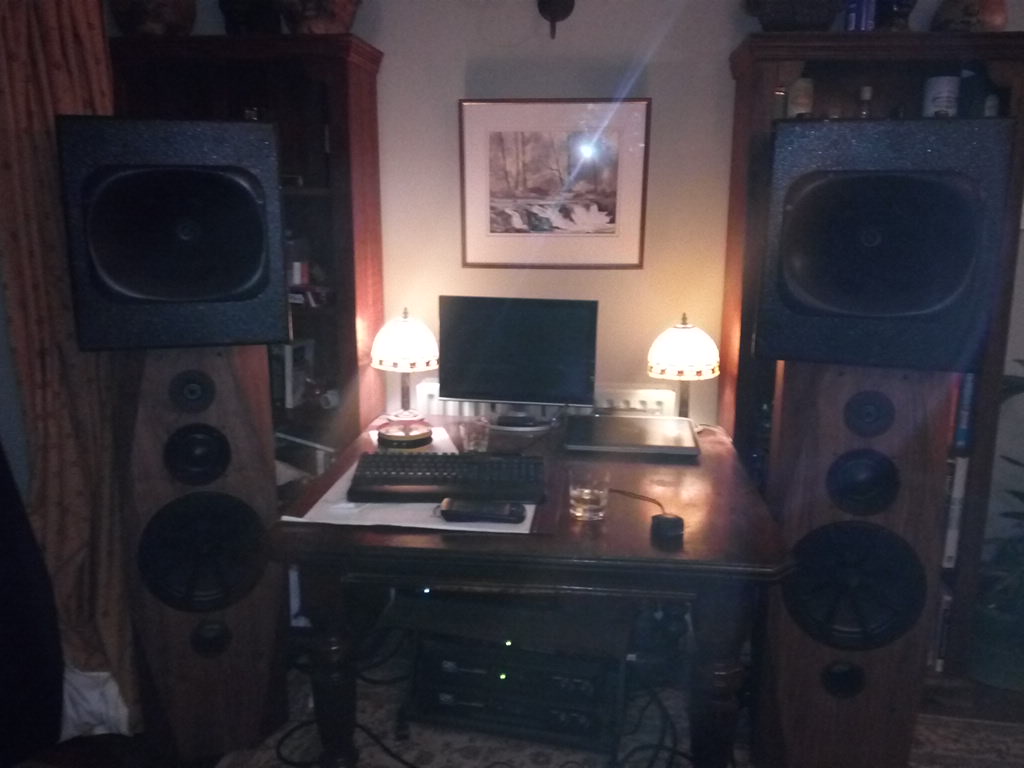
I thought I could use the Volt 3143 12" woofers in those speakers to see whether relieving the SB23's of the heavy lifting and crossing them over to the volt woofers at about 90Hz would make a difference to the sound.
Well here are the measurements with a quick and dirty 3-way harsch x-over at 600 and 90 hz.
So far, despite the 4 SB23's being able to play happily down low and with a fairly decent VD - this is 4x8 inch drivers after all, the difference is like night and day.
There simply is no replacement for displacement......
So I am thinking bring on the um15-22's......😀😀😀
It's been a few weeks (almost)... how's the long term listening impression. Usually it's quite easy to get blown away on a first listening session. But later on you'll likely notice some warts etc. How are the horns holding up after a longer period? Have you been listening to them these past couple of days?
Just curious. I don't expect them to disappoint, on the contrary. But I learned to make my judgment on sound over a longer period. Still happy after that? You're on to something 🙂...
You are quite right wesayso,
In fact that is part of the reason I wanted to 'let the dust settle' and spend some hours just listening.
OK. So as you know, I have a few nice speakers for direct comparison -
One uses the scanspeak 12MU for the mid (the most important driver in a 3-way in my opinion), and one the Volt VM752 - both speakers are optimized as far as I can take them with sorbothane, extensive bracing, damping etc. etc.
So what amazes me is the sound from these synergies. There is only a few hundred quid of drivers in these things and the sound is incredible.
Don't get me wrong - the three way sealed monitors I designed are excellent 'social, party speakers'. i.e. - they create a very wide sound stage which doesn't collapse off axis - they create a true 'wall of sound'.
But the sound stage is an enveloping kind of 'they are here' which probably is not completely true to the recording, I think largely a result of their very broad, even power response in room:
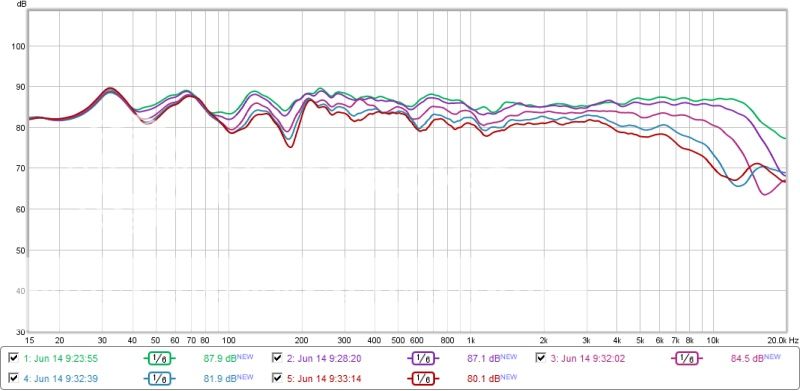
The larger three-way prestige based speakers (but my own crossovers and cabinet mods), have a less pronounced broad directivity, due to the VM752 being horn loaded and the known beaming of the Scanspeak R2904/7000.09 ring radiator.
These are obviously high resolution units too and a lot of time went into optimizing the cabinets with additional bracing and damping to remove cabinet coloration (a problem with the stock kit enclosure).
However, I still feel our home cooked Xbush synergy sounded better.....
They are all fabulous speakers, they all sound different as a result of design considerations and I guess a lot of it is down to personal taste....
BUT, without doubt the Xbush synergies have better resolution, sharper imaging, and create a soundscape which moves from 'they are here' to 'I am there' more than the others.
The window into the recording is much more transparent - I can hear the acoustic space in the background of the recording very clearly.
I am almost certain this is due to the absence of diffractions/reflections from the CD the synergy design provides:
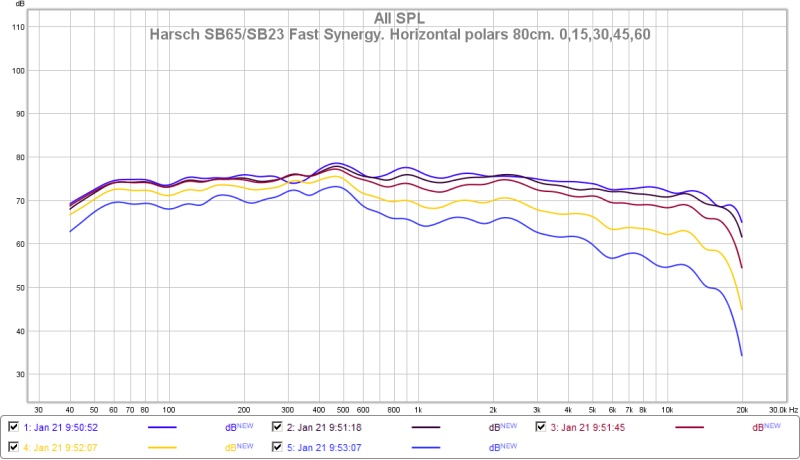
However, again it s a choice of design considerations. The sweet spot, particularly for my sealed monitors is almost the whole room, whilst for the Xbush is perhaps a two seater sofa - (although I suspect this is partly due to a restricted maximum listening distance in my room).
So in summary, for selfish single or perhaps two person critical listening, when you want the highest fidelity into the recording, the Xbush reigns supreme.
However, I would not choose them for my living room party speakers, and I would not be allowed to put them there anyway as currently they have virtually zero WAF! (Also an important design consideration in some households...)
So I am awaiting the conversion of my garage into a dedicated listening room. They will likely be repainted, and placed upon a 100L braced cab of similar width/depth housing an 18inch woofer to cover from ~100hz down.
I can then selfishly enjoy some of the most incredible listening experiences I have had, on my own with a nice single malt, without anyone commenting on how 'large they look'. 😀
In fact that is part of the reason I wanted to 'let the dust settle' and spend some hours just listening.
OK. So as you know, I have a few nice speakers for direct comparison -
One uses the scanspeak 12MU for the mid (the most important driver in a 3-way in my opinion), and one the Volt VM752 - both speakers are optimized as far as I can take them with sorbothane, extensive bracing, damping etc. etc.
So what amazes me is the sound from these synergies. There is only a few hundred quid of drivers in these things and the sound is incredible.
Don't get me wrong - the three way sealed monitors I designed are excellent 'social, party speakers'. i.e. - they create a very wide sound stage which doesn't collapse off axis - they create a true 'wall of sound'.
But the sound stage is an enveloping kind of 'they are here' which probably is not completely true to the recording, I think largely a result of their very broad, even power response in room:

The larger three-way prestige based speakers (but my own crossovers and cabinet mods), have a less pronounced broad directivity, due to the VM752 being horn loaded and the known beaming of the Scanspeak R2904/7000.09 ring radiator.
These are obviously high resolution units too and a lot of time went into optimizing the cabinets with additional bracing and damping to remove cabinet coloration (a problem with the stock kit enclosure).
However, I still feel our home cooked Xbush synergy sounded better.....
They are all fabulous speakers, they all sound different as a result of design considerations and I guess a lot of it is down to personal taste....
BUT, without doubt the Xbush synergies have better resolution, sharper imaging, and create a soundscape which moves from 'they are here' to 'I am there' more than the others.
The window into the recording is much more transparent - I can hear the acoustic space in the background of the recording very clearly.
I am almost certain this is due to the absence of diffractions/reflections from the CD the synergy design provides:

However, again it s a choice of design considerations. The sweet spot, particularly for my sealed monitors is almost the whole room, whilst for the Xbush is perhaps a two seater sofa - (although I suspect this is partly due to a restricted maximum listening distance in my room).
So in summary, for selfish single or perhaps two person critical listening, when you want the highest fidelity into the recording, the Xbush reigns supreme.
However, I would not choose them for my living room party speakers, and I would not be allowed to put them there anyway as currently they have virtually zero WAF! (Also an important design consideration in some households...)
So I am awaiting the conversion of my garage into a dedicated listening room. They will likely be repainted, and placed upon a 100L braced cab of similar width/depth housing an 18inch woofer to cover from ~100hz down.
I can then selfishly enjoy some of the most incredible listening experiences I have had, on my own with a nice single malt, without anyone commenting on how 'large they look'. 😀
Last edited:
So what amazes me is the sound from these synergies...I still feel our home cooked Xbush synergy sounded better...
...without doubt the Xbush synergies have better resolution, sharper imaging, and create a soundscape which moves from 'they are here' to 'I am there' more than the others...The window into the recording is much more transparent - I can hear the acoustic space in the background of the recording very clearly...
However, again it s a choice of design considerations. The sweet spot, particularly for my sealed monitors is almost the whole room, whilst for the Xbush is perhaps a two-seater sofa (although I suspect this is partly due to a restricted maximum listening distance in my room).
Some observations based on yours:
1) It looks like the effective non-straight-sided coverage angles of your DIY "synergies" is less than 90 degrees horizontally, which should be factored into the width of the sound stage that you're experiencing (two seats). As a point of departure for talking purposes only, the K-402 multiple entry horn does almost 100 degrees horizontally and 60 vertically and it has no limitations of sound stage from wall to wall, standing on top of a chair or prone on the floor, down to about 175 Hz, whereupon the room boundaries themselves begin to support the horn's polars--down to about 40 Hz. I've found that the lower frequency that you can support the polars, the more convincing the imaging and overall performance.
2) Increasing the distance to the horn mouths to your listening position always increases the apparent "realness" or sense of actual musicians in the room--but further away. When I stand close to the back of my 12-metre-long listening room, it sounds very convincing, but the sound stage imaging and the sense of LF impact is much, much better the closer you get, up to about ~1.5-2 metres from the front three horn mouths (two in corners, one in the middle) all with the same same coverage angles
3) I see from your off-axis FR plots that your pattern control begins to be lost at ~500 Hz. The listening band 100-500 Hz is pretty critical in terms of midbass "realness" and presence, and having those frequencies bounce around the front portion of the room (much higher power response in order to compensate for the loss of pattern control) I find to be a big deal in terms of changing the timbre and character of the sound.
4) The decision to use a short, small horn to a direct-radiating woofer up to above tuning fork (e.g., A440) frequencies has its advantages and its costs. Direct radiating woofers themselves produce a certain sound (mainly due to significant modulation distortion) which piles up at the highest frequencies of the woofer, which I assume is ~600 Hz. The sound at and below that frequency will sound significantly less transparent and focused because you've chosen to use a smaller loudspeaker--which is okay, since you're fully aware that you've made those choices--in this case, smaller loudspeakers to fit the decor (what the eyes see, not what the ears hear).
I think that you're getting all you can out of the design decisions that you've made, and it's good to read that you're still impressed with the multiple-entry horn design. I am, too--very impressed.
Chris
Chris thanks for your input -
I agree with all you have said!
For me the 18"x20" front baffle size is as large as I can go - so you are absolutely right, 500hz is the limit to the CD.
I hope to assist them with heavy room treatments in my 'dedicated listening space'!
I am surprised that the K-402 can hold pattern control down to 175Hz though, but I guess it is over a meter wide!
I agree with all you have said!
For me the 18"x20" front baffle size is as large as I can go - so you are absolutely right, 500hz is the limit to the CD.
I hope to assist them with heavy room treatments in my 'dedicated listening space'!
I am surprised that the K-402 can hold pattern control down to 175Hz though, but I guess it is over a meter wide!
Yes - the K-402 horn has about the same mouth size and axial length as the Danley SH-96 horn, except it uses a modified tractrix mouth instead of a dual-flare straight-sided horn of the Danley.
Chris
Chris
Last edited:
Thanks for the update Bushmeister - awesome that they still reign supreme for 1 or 2 person critical listening. Perfect for near or mid field production or mastering monitors.
I have been off on long term listening to my other FAST direct radiators to get an impression of new drivers for another thread.
Also now dabbling in building some class AB and class A amps for the joy of it (soldering is kind of therapeutic) 🙂
I have been off on long term listening to my other FAST direct radiators to get an impression of new drivers for another thread.
Also now dabbling in building some class AB and class A amps for the joy of it (soldering is kind of therapeutic) 🙂
Some observations based o
4) The decision to use a short, small horn to a direct-radiating woofer up to above tuning fork (e.g., A440) frequencies has its advantages and its costs. Direct radiating woofers themselves produce a certain sound (mainly due to significant modulation distortion) which piles up at the highest frequencies of the woofer, which I assume is ~600 Hz. The sound at and below that frequency will sound significantly less transparent and focused because you've chosen to use a smaller loudspeaker--which is okay, since you're fully aware that you've made those choices--in this case, smaller loudspeakers to fit the decor (what the eyes see, not what the ears hear).
Chris
One question regarding this point Chris - the Xbush is a synergy design with no direct radiators at all - two 8 inch horn mounted woofers with dual taps per speaker crossover at approx 600 hz:
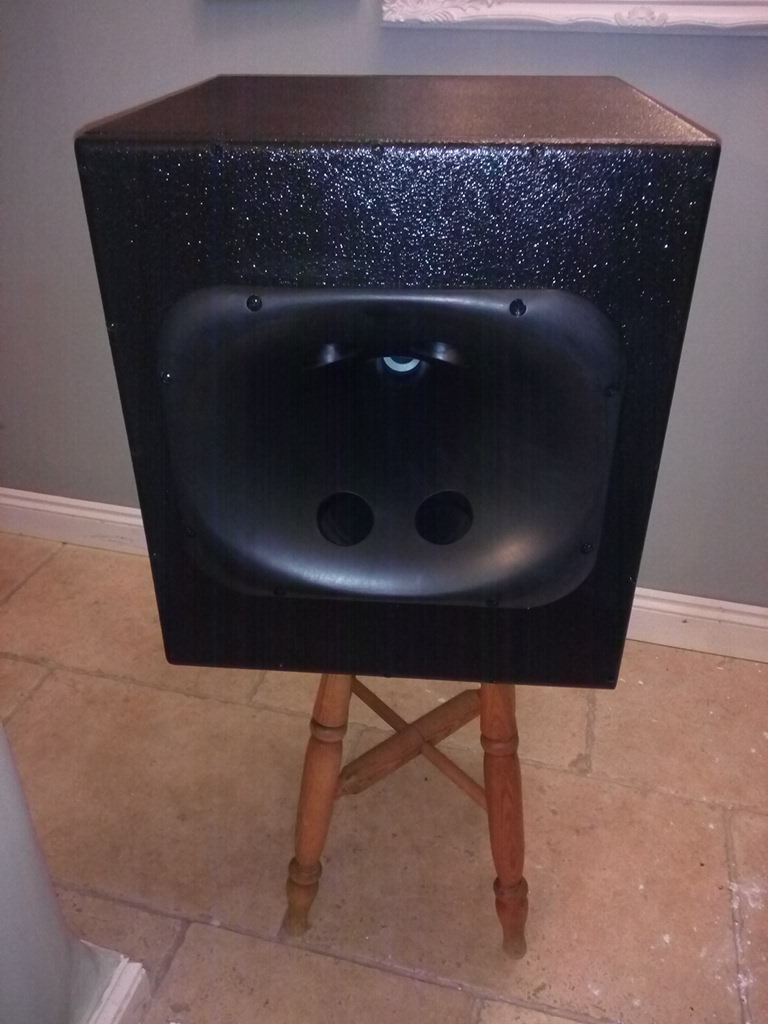
The X-Bush is quite capable of running down to 30hz without the assistance of a direct radiator at all at over 100dB and very low distortion:
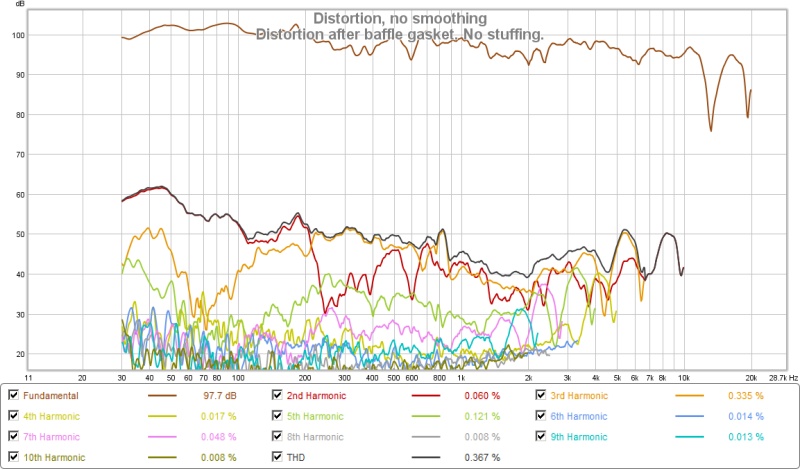
I am suggesting an 18" direct radiator to supplement this performance - possibly from 80 - 100 hz down - i.e. a sub woofer module.
So I assume this point is not referring to the x-bush or any of the design decisions I have made? But more to the SEOS type designs?
Last edited:
Cool, thanks for the clarification. My comment about curved side walls on the horn can also be amended to a large degree. I was looking mostly at the #1 post on this thread design for the location of the woofers.
Ah, yes I can see how that first post could be a little misleading as the drawings were X's initial concepts - but a fair bit removed from my plans!
It is a long thread - I should really put a summary post in somewhere.
It is a long thread - I should really put a summary post in somewhere.
- Home
- Loudspeakers
- Multi-Way
- A Bookshelf Multi-Way Point-Source Horn